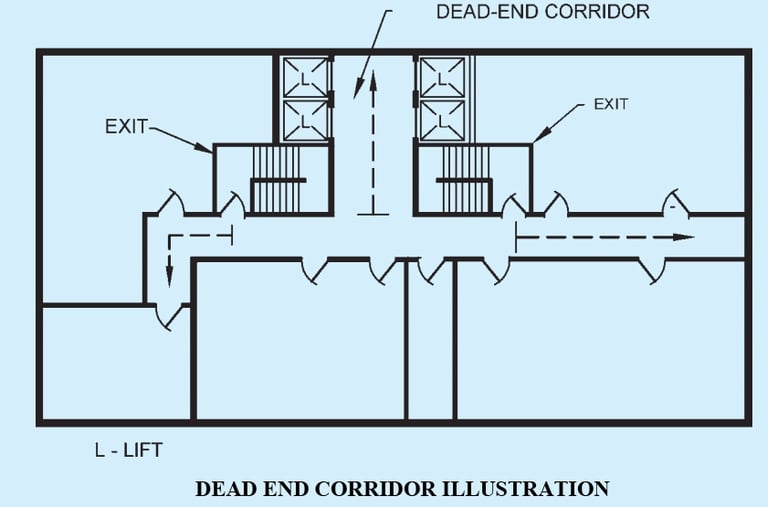Special Note
Arrangement of exits
a) Exits shall be so located that the travel distance on the floor shall not exceed the distance given in Table 5.
b) Travel distance shall be measured from the most remote point within a storey or a mezzanine floor along the natural and unobstructed path of horizontal or vertical egress travel to the door to an exit.
c) The dead end corridor length in exit access shall not exceed 6 m for educational, institutional and assembly occupancies. For other occupancies, the same shall be 15 m (see Fig. below)
d) Exits shall be placed as remote from each other as possible and shall be arranged to provide direct access in separate directions from any point in the area served
Building travel distance calculator
Introducing the Travel Distance Calculator, a powerful tool designed specifically for architects to streamline their workflow and ensure compliance with the National Building Code (NBC) 2016. This innovative architect calculator allows you to effortlessly determine the maximum travel distances for different building types and construction methods, saving you valuable time and effort.
Our Travel Distance Calculator, along with our suite of other architect calculators, is built upon the guidelines and regulations set forth in the NBC 2016. By leveraging the latest information from this authoritative code, we provide architects with accurate and reliable results, enabling them to make informed decisions quickly and efficiently.
Whether you're working on residential, educational, industrial, or hazardous building projects, our Travel Distance Calculator has you covered. Simply input the building type, construction type, and other relevant parameters, and the calculator will instantly provide you with the maximum allowable travel distances based on the NBC 2016 standards. By utilizing our architect calculator, you can streamline your design process, ensure code compliance, and focus on what matters most - creating exceptional architectural designs.
Don't waste precious time manually calculating travel distances or sifting through the NBC 2016 guidelines.
Types of Construction
The National Building Code of India (NBC) 2016 classifies buildings into different construction types based on their fire resistance and materials used. The classifications relevant to fire and life safety are as follows:
Type 1 Construction: Fire-Resistant
Materials: Composed entirely of non-combustible materials.
Characteristics: This type includes structures that are designed to withstand fire for extended periods, typically with fire-resistive ratings of 2 hours or more.
Examples: High-rise buildings, hospitals, and other critical facilities.
Type 2 Construction: Non-Combustible
Materials: Primarily non-combustible materials but may include some combustible elements.
Characteristics: These buildings are less fire-resistant than Type 1 but still provide some level of protection against fire.
Examples: Commercial buildings and warehouses.
Type 3 Construction: Ordinary
Materials: Combines non-combustible exterior walls with combustible interior elements.
Characteristics: While the exterior is built to resist fire, the interior can include flammable materials, making these buildings more susceptible to fire spread.
Examples: Residential buildings and small commercial structures.
Type 4 Construction: Heavy Timber
Materials: Made from large pieces of timber that are combustible but have significant mass.
Characteristics: These buildings are often older and constructed using heavy timber, which can perform well in fire due to its size, although they are still considered combustible.
Examples: Historic structures, barns, and some industrial buildings.
These classifications help in determining the appropriate fire safety measures and construction practices required for different types of buildings, ensuring safety for occupants and compliance with regulations outlined in the NBC 2016, particularly in Chapter 4, which focuses on fire and life safety


